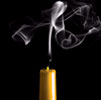

Everyone hates fire drills and regards them as a waste of time, however, a good smoke detector and a rehearsed exit process can save lives.
There is more to devising a fire-safety plan for your organisation than meets the eye. An evacuation plan springs to mind, but has your organisation given any thought to the ultimate in an early warning system – a smoke alarm?
Smoke alarms are designed to warn occupants of a building in the event of a fire, as well as to minimise false alarms. If the fire alarm sounds, follow these steps and become thoroughly familiar with them. It is imperative that all staff members are aware of the company fire drill, prior to a smoke alarm warning.
* Leave immediately by your escape plan. Every second counts, do not waste time picking up valuables.
* Do not open any inside door without first feeling its surface. If it is hot, or if you see smoke seeping through cracks, do not open that door! Instead, use an alternate exit. If the inside of the door is cool, place your shoulder against it, open it slightly and be ready to slam it shut if heat and smoke rush in.
* If the air is smoky, stay close to the floor. Stay calm and breathe shallowly through a cloth – a wet one if possible.
* Once outside, go to your selected meeting place and make sure everyone is there.
* Call the fire department from your cellphone, not from a landline within the building.
* Do not return to your office until the fire officials say that it is all right to do so.
Consider positioning smoke alarms in the following areas:
* Every floor of the building.
* All stairwells – these act like chimneys for smoke and heat.
* Every office or area/room where electrical appliances are operated (eg, portable heaters or airconditioners).
* Basement parking areas.
Smoke, heat and combustion products rise to the ceiling and spread horizontally. Mounting the smoke alarm on the ceiling in the centre of the room places it closest to all points in the room. When mounting an alarm on the ceiling, locate it at a minimum of 10 cm from the side wall. When mounting the alarm on the wall, use an inside wall with the top edge of the alarm at a minimum of 10 cm and a maximum of 30,5 cm below the ceiling.
Additionally, smoke alarms should not be installed within 1 m of the door to a kitchen; forced air supply ducts used for heating or cooling; ceiling or ventilating fans, or other high airflow areas.
To avoid the unnecessary dispatch of the fire officials, note that the following areas could generate false alarms:
* Dusty; very humid – moisture or steam can cause false alarms, as well as insect-infested areas.
* Kitchens/canteens – normal cooking may cause false alarms. If a kitchen/canteen alarm is desired, it should have an alarm silence feature or be a photoelectric type.
* Near fluorescent lights. Electronic noise may cause false alarms.
The following good safety habits are always useful for any organisation to follow:
* Install and maintain a fire extinguisher on every level of the building; in the canteen/kitchen, basement and garage. Know how to use a fire extinguisher prior to an emergency.
* Make a floorplan indicating all doors and windows and at least two escape routes from each office or room. Alternative evacuation methods need to be implemented should the facility have only one exit.
* Hold a staff meeting and discuss your escape plan, showing everyone what to do in case of a fire. All emergency/evacuation staff must be trained in accordance with the OSHA, Act 85 of 1993.
* Determine a place outside your organisation where you all can meet if a fire occurs.
* Familiarise everyone with the sound of the smoke alarm and train them to leave the building when they hear it.
* Practice a fire drill at least every six months. Practice allows all occupants to test your plan before an emergency.
For more information contact Lynn Bennett, Chubb Security, +27 (0)11 761 7000, [email protected], www.chubb.co.za
© Technews Publishing (Pty) Ltd. | All Rights Reserved.